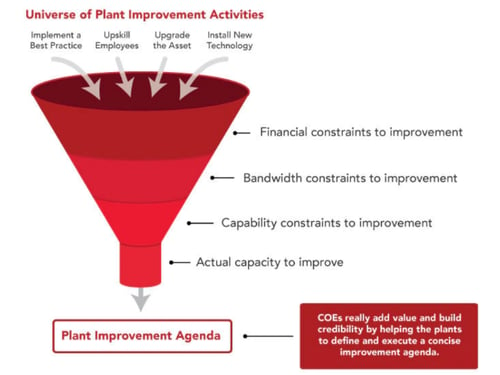Align Your Client Facing Teams with a Center of Excellence
 If you’re like most in manufacturing, continuous improvement is always on your mind. You spend hours finding ways to streamline production, innovate, bring more value to your customers, increase your revenue, and on and on. One way that manufacturers realize improvement in operations is through formal Centers of Excellence (CoE). It’s hardly a new concept on the production side of manufacturing but have you considered this approach for your marketing, sales, and customer service (a.k.a. client-facing) teams too? Here’s why you should.
If you’re like most in manufacturing, continuous improvement is always on your mind. You spend hours finding ways to streamline production, innovate, bring more value to your customers, increase your revenue, and on and on. One way that manufacturers realize improvement in operations is through formal Centers of Excellence (CoE). It’s hardly a new concept on the production side of manufacturing but have you considered this approach for your marketing, sales, and customer service (a.k.a. client-facing) teams too? Here’s why you should.
Centers of Excellence can take many forms: a team of people within the company, a shared facility or office, or a whole separate entity. A CoE should have broader scope and more longevity than a task force or committee because it must combine learning and oversight around a specific area, driving and managing change in an integrated manner.
But no matter how they’re set up, the best CoEs have focus. That is, they’re designed to tackle a specific challenge or idea within an organization, providing leadership, best practices, research, support and/or training.
Of course, once new ideas start percolating, especially about procedures, and technology and how they can improve your organization, it can be easy to get carried away. But in the long run you’ll have better results not by chasing perfection, but rather by staying focused on those few, most critical improvements that will accomplish your goal. As Roger Price writes in Industry Week , “plants don’t need someone to give them a complete account of everything they’re doing wrong, thereby adding to their already long improvement wish list. Rather, what they need is someone to help them identify and execute against the short list of improvements that will really drive value.” That goes for client facing teams too.

A perfect example of a CoE in the industrial manufacturing space is a team that works with plant leadership to partner on the targeted critical improvements that will have a large impact or ROI. This CoE is responsible for keeping those improvements on track, holding people accountable for change, and providing the right guidance and support to progress them thru to fruition. For example, the CoE might select a robust CRM to track and integrate all marketing, sales, and customer service activity in order to improve transparency between departments, automate manual tasks, and clarify metrics. Not only will they sell the teams on the benefits of the new CRM, they’ll ensure everyone receives training and is using it regularly. Buying new software may sound like a simple example, but it requires the right group of people and support from leadership to really have the impact you need.
If the CoE remains true to its focus, it can help keep client facing teams focused and aligned too. According to HubSpot, "tightly aligned" companies achieve 24 percent faster three-year revenue growth and 27 percent faster three-year profit growth. Sales and marketing alignment is invariably tied to revenue, and therefore, profits. A collaborative approach creates more strategic, efficient marketing campaigns that result in more deals, more revenue, and accelerated growth for companies.”
Over the past 20 years, the complexity in the sales and marketing space has dramatically increased, creating the imperative for your teams to be working together to provide a good buying experience for your customers. Your revenue depends on it. The good news? As a B2B sales and marketing consultant in the manufacturing space, I am seeing many more organizations develop CoEs for their client facing teams (i.e. sales, marketing, customer service, parts/service department, etc.).
Much like a plant floor, client facing teams need to be progressing leads and inquiries down the REVUNUE-MAKING MANUFACTURING LINE, but we all know sales and marketing experience roadblocks from time to time. CoEs are an effective way to bring internal resources and specialists to the same table to share ideas and eliminate barriers to collaboration). They focus on providing training, best practices, and resources for all of these different teams, while also gathering the data and learnings from them to create a positive feedback loop.
You may be thinking, “that all sounds great, but where do I start?”
Answer these questions for your organization and you’ll have your CoE charter !
Gartner describes setting up a CoE as, “concentrating existing expertise and resources in a discipline or capability to attain and sustain world-class performance and value.” Who wouldn’t want to do that? Fortunately, it doesn’t just apply to the production line. It’s a powerful tool for the client facing teams who drive growth and profitability too. We’d love to show you how.
Comments